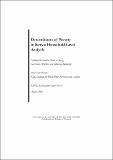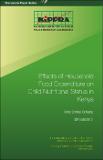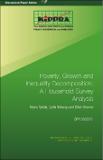| dc.date.accessioned | 2021-03-03T08:00:46Z | |
| dc.date.available | 2021-03-03T08:00:46Z | |
| dc.date.issued | 2002 | |
| dc.identifier.uri | http://repository.kippra.or.ke/handle/123456789/2732 | |
| dc.description.abstract | Identifying and measuring poverty require data on economic conditions of households and individuals. Such data are typically gathered through household surveys. Household surveys collect data on demographics, incomes, expenditure, and other characteristics such as area of residence and participation in the labour force. Data from household surveys are suitable not only for identifying and aggregating poverty but also for constructing poverty profiles. Household surveys have two shortcomings: first, they require considerable expertise to conduct, and second, they involve large expenditures to collect and analyse. For these reasons, household surveys are conducted only occasionally. Moreover, there is usually a long time interval between one survey and the next, except when the survey is designed to collect panel data. As a consequence, household surveys cannot be used to construct annual or high frequency poverty indices or profiles. Yet, such indices and profiles are key in evaluating the effectiveness of poverty reduction strategies... | en |
| dc.language.iso | en | en |
| dc.publisher | The Kenya Institute for Public Policy Research and Analysis (KIPPRA) | en |
| dc.relation.ispartofseries | DP/12/2002; | |
| dc.subject | Household poverty | en |
| dc.subject | Poverty indices | en |
| dc.subject | Developing countries | en |
| dc.subject | Household Survey | en |
| dc.title | Discussion Paper No. 12 of 2002 on Predicting Household Poverty: A Methodological Note with a Kenyan Example | en |
| dc.type | KIPPRA Publications | en |
| ppr.contributor.author | Mwabu, Germano; Kimenyi, Mwangi S. & Kimalu, Paul | |




